Abstract
1. Purine analogues have been examined for anxiolytic- and anxiogenic-like activity in mice, by use of the elevated plus-maze. 2. The selective A1 receptor agonist, N6-cyclopentyladenosine (CPA) had marked anxiolytic-like activity at 10 and 50 microg kg(-1), with no effect on locomotor performance at these doses. 3. The A1 selective adenosine receptor antagonist, 1,3-dipropyl-8-cyclopentylxanthine (CPX) had no significant effect on anxiety-related measures or locomotor behaviour, but blocked the anxiolytic-like activity of CPA. The hydrophilic xanthine, 8-(p-sulphophenyl) theophylline did not prevent anxiolysis by CPA. 4. Caffeine had anxiogenic-like activity at 30 mg kg(-1) which was prevented by CPA at 50 micro kg(-1). 5. The A2 receptor agonist, N6-[2-(3,5-dimethoxyphenyl)-2(2-methylphenyl)-ethyl]adenosine (DPMA) had no effect on anxiety behaviour but depressed locomotor activity at the highest dose tested of 1 mg kg(-1). The A2 receptor antagonist, 1,3-dimethyl-l-propargylxanthine (DMPX) had no effect on anxiety-related measures or locomotion and did not modify the anxiolytic-like activity of CPA. 6. Administration of DPMA in combination with anxiolytic doses of CPA prevented the anxiolytic-like activity of the latter. 7. The results suggest that the selective activation of central A1 adenosine receptors induces anxiolytic-like behaviour, while the activation of A2 sites causes locomotor depression and reduces the effects of A1 receptor activation. The absence of any effect of CPX alone suggests that the receptors involved in modulating behaviour in the elevated plus-maze in mice are not activated tonically by endogenous adenosine.
Full text
PDF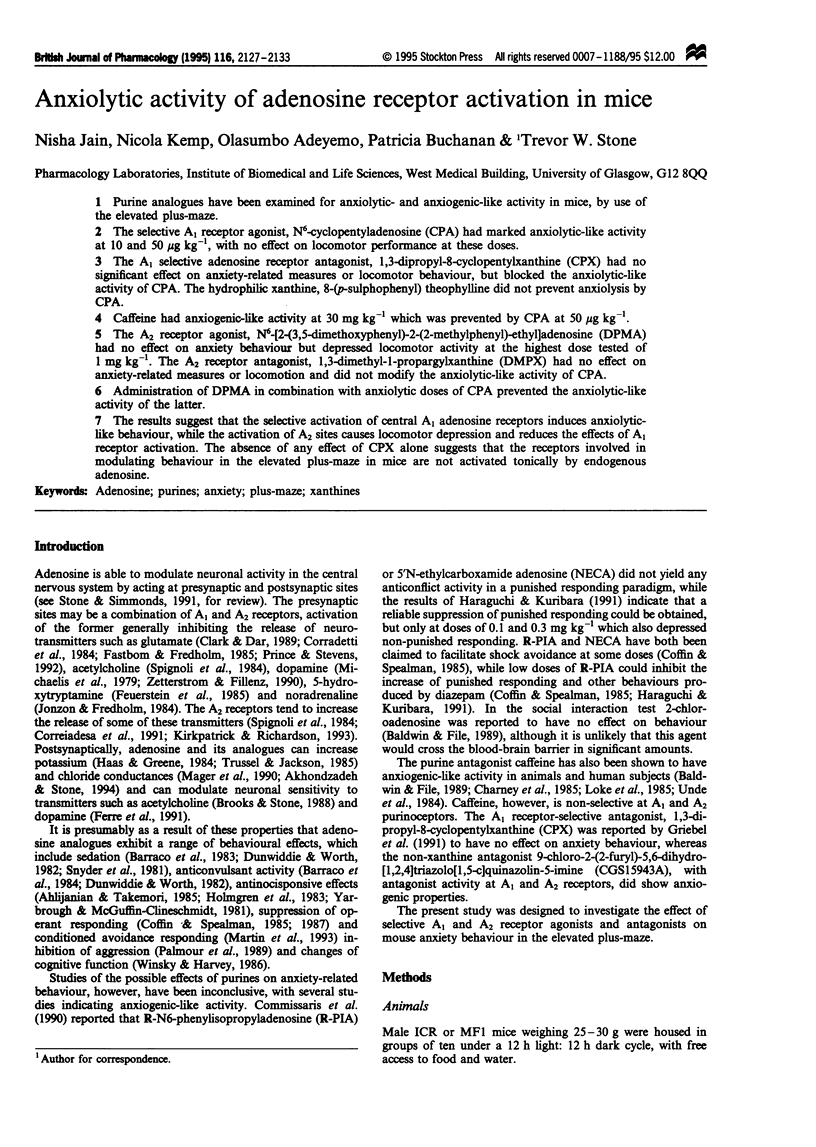
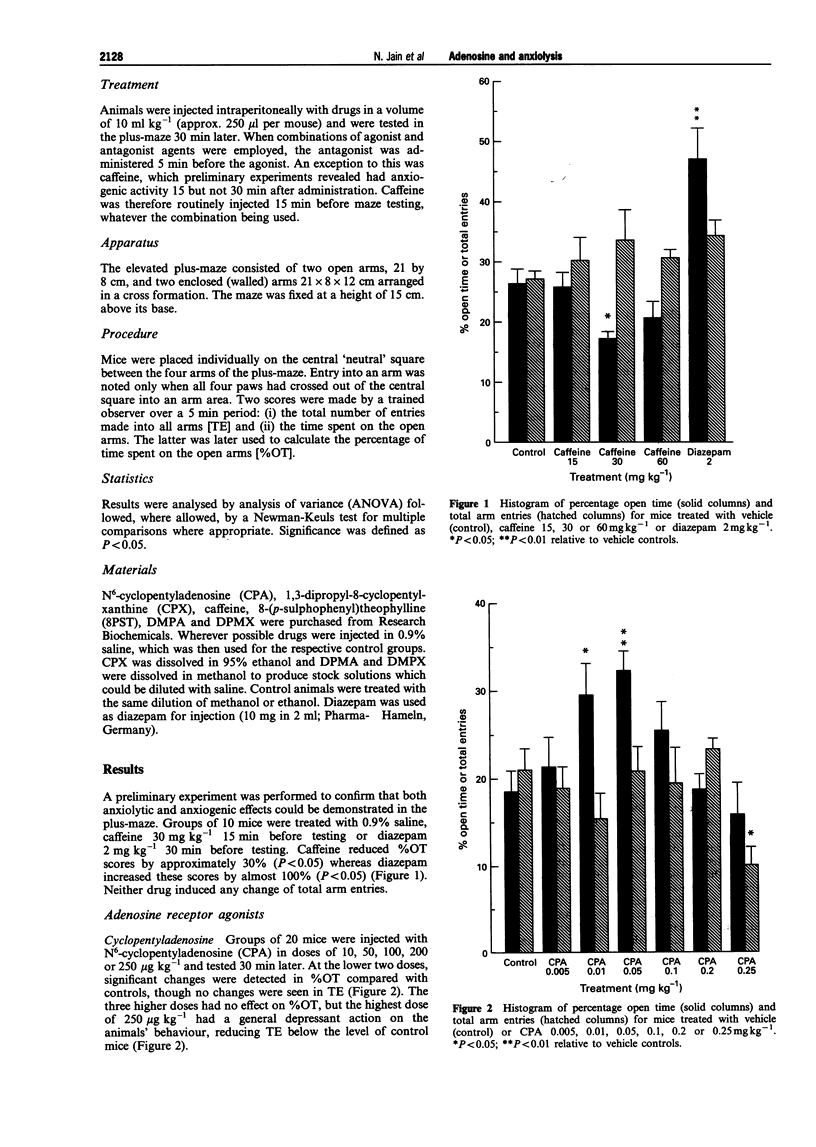
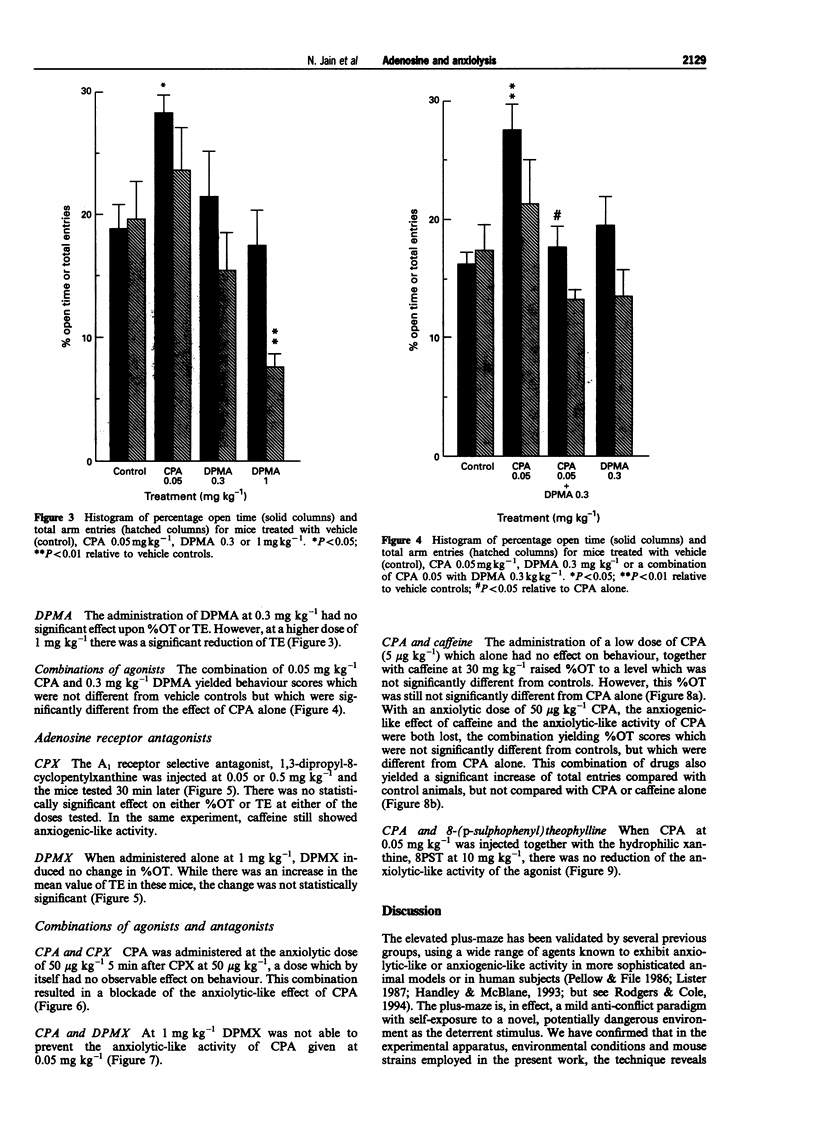
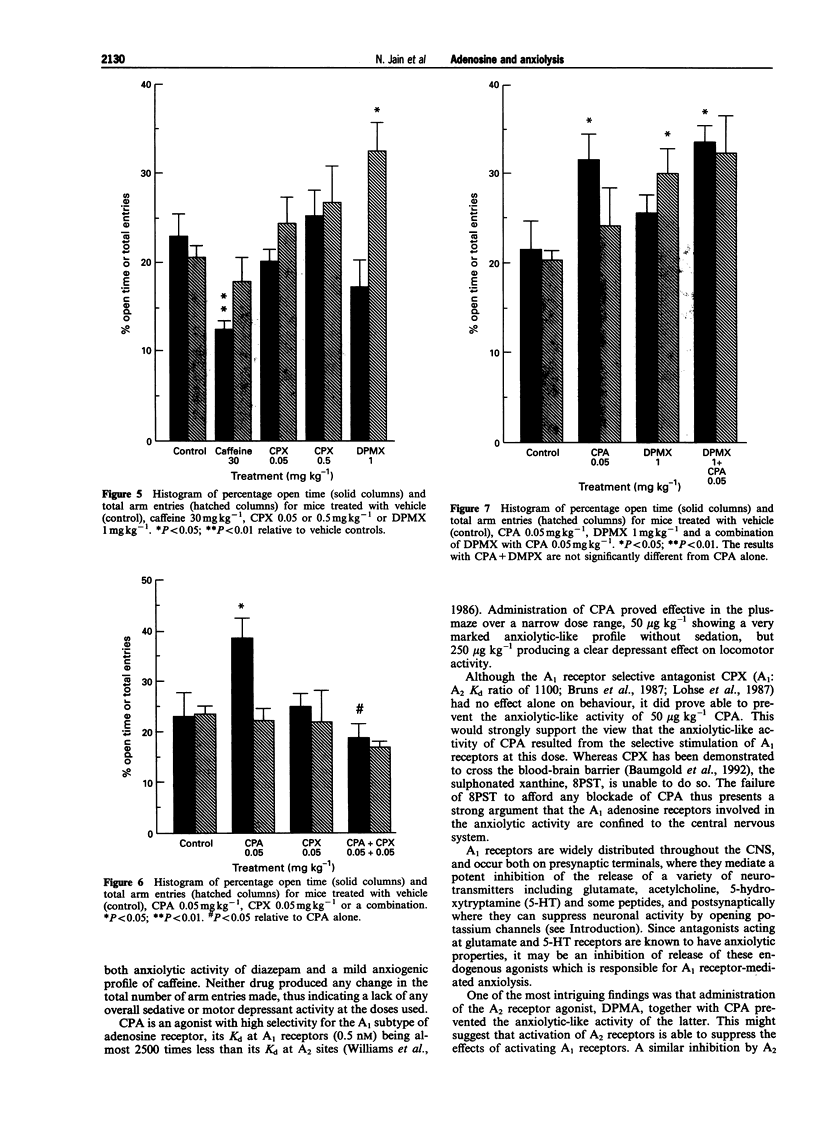
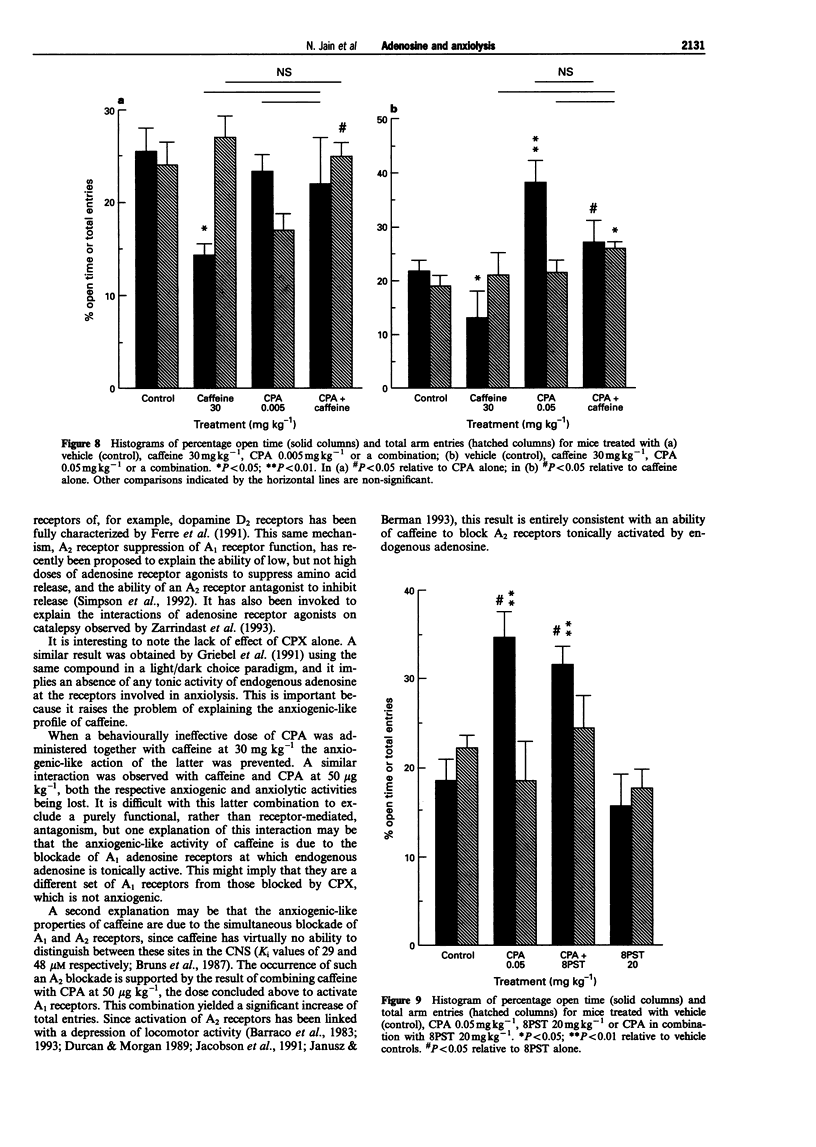
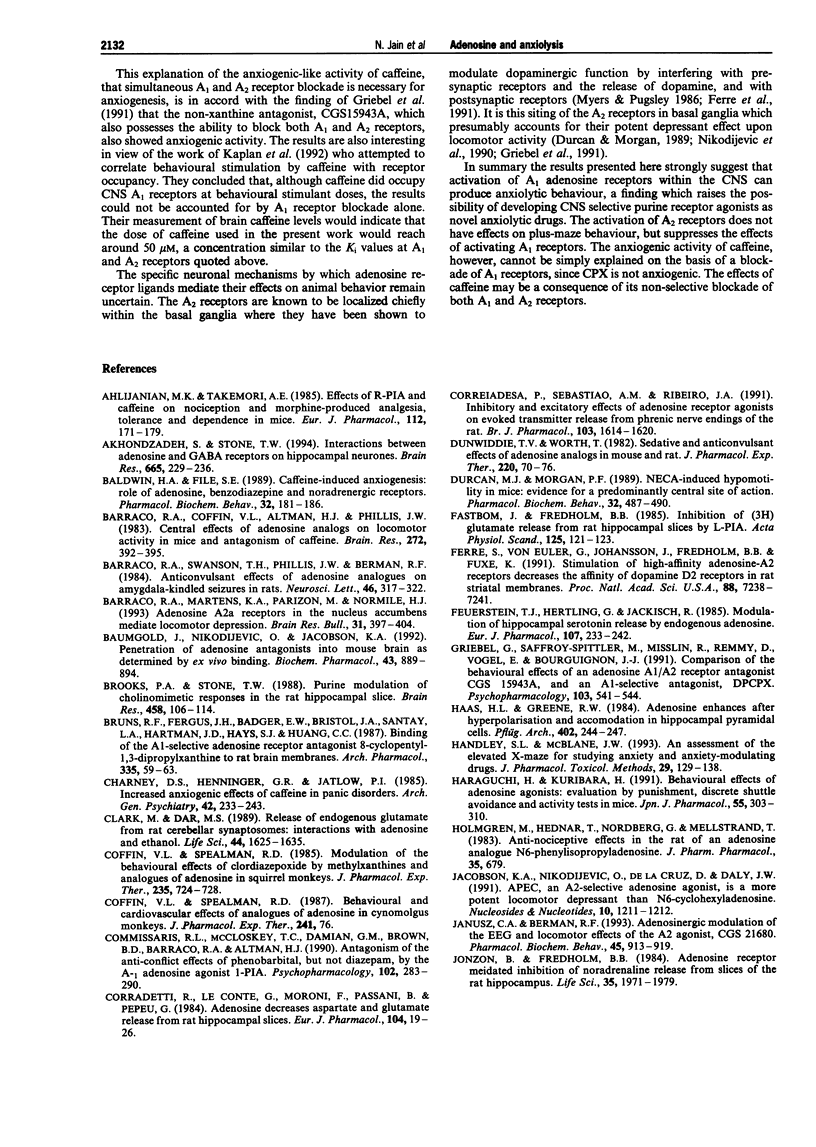
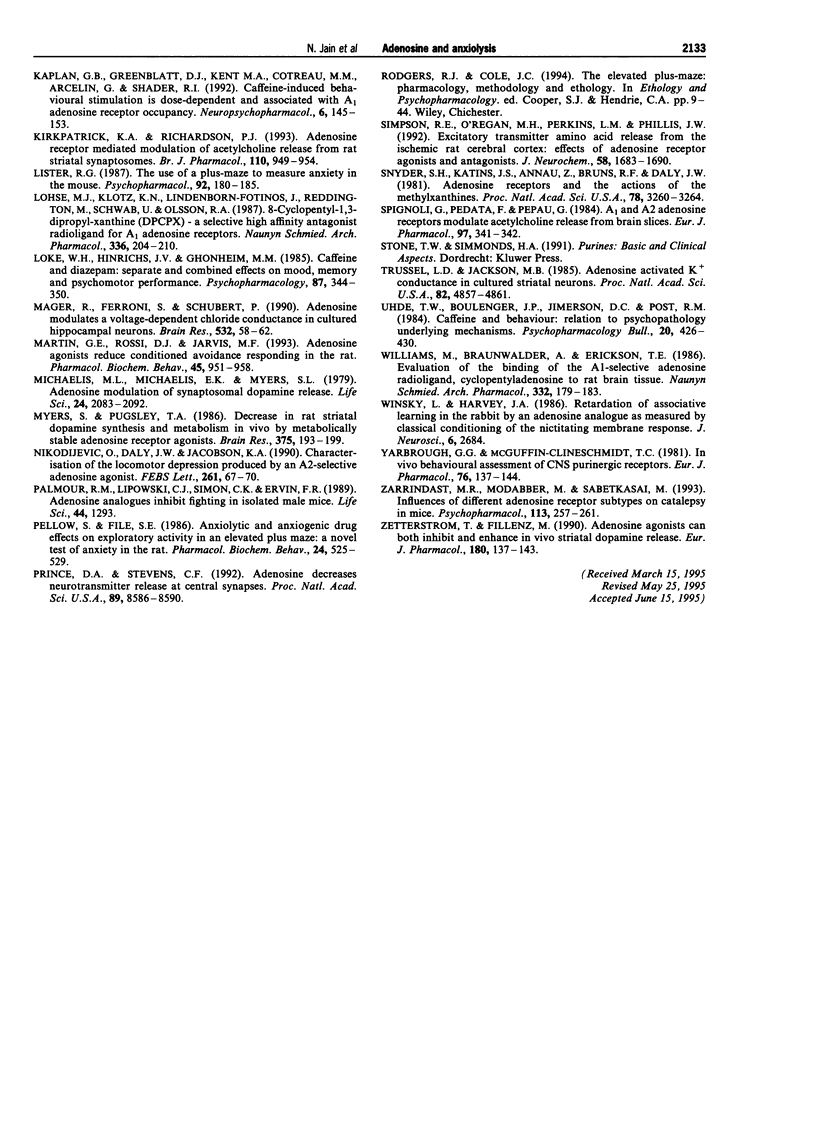
Selected References
These references are in PubMed. This may not be the complete list of references from this article.
- Ahlijanian M. K., Takemori A. E. Effects of (-)-N6-(R-phenylisopropyl)-adenosine (PIA) and caffeine on nociception and morphine-induced analgesia, tolerance and dependence in mice. Eur J Pharmacol. 1985 Jun 7;112(2):171–179. doi: 10.1016/0014-2999(85)90493-5. [DOI] [PubMed] [Google Scholar]
- Akhondzadeh S., Stone T. W. Interaction between adenosine and GABAA receptors on hippocampal neurones. Brain Res. 1994 Dec 5;665(2):229–236. doi: 10.1016/0006-8993(94)91342-0. [DOI] [PubMed] [Google Scholar]
- Baldwin H. A., File S. E. Caffeine-induced anxiogenesis: the role of adenosine, benzodiazepine and noradrenergic receptors. Pharmacol Biochem Behav. 1989 Jan;32(1):181–186. doi: 10.1016/0091-3057(89)90230-x. [DOI] [PubMed] [Google Scholar]
- Barraco R. A., Coffin V. L., Altman H. J., Phillis J. W. Central effects of adenosine analogs on locomotor activity in mice and antagonism of caffeine. Brain Res. 1983 Aug 8;272(2):392–395. doi: 10.1016/0006-8993(83)90591-7. [DOI] [PubMed] [Google Scholar]
- Barraco R. A., Martens K. A., Parizon M., Normile H. J. Adenosine A2a receptors in the nucleus accumbens mediate locomotor depression. Brain Res Bull. 1993;31(3-4):397–404. doi: 10.1016/0361-9230(93)90233-2. [DOI] [PubMed] [Google Scholar]
- Barraco R. A., Swanson T. H., Phillis J. W., Berman R. F. Anticonvulsant effects of adenosine analogues on amygdaloid-kindled seizures in rats. Neurosci Lett. 1984 May 18;46(3):317–322. doi: 10.1016/0304-3940(84)90118-6. [DOI] [PubMed] [Google Scholar]
- Baumgold J., Nikodijevic O., Jacobson K. A. Penetration of adenosine antagonists into mouse brain as determined by ex vivo binding. Biochem Pharmacol. 1992 Feb 18;43(4):889–894. doi: 10.1016/0006-2952(92)90257-j. [DOI] [PMC free article] [PubMed] [Google Scholar]
- Brooks P. A., Stone T. W. Purine modulation of cholinomimetic responses in the rat hippocampal slice. Brain Res. 1988 Aug 16;458(1):106–114. doi: 10.1016/0006-8993(88)90501-x. [DOI] [PubMed] [Google Scholar]
- Bruns R. F., Fergus J. H., Badger E. W., Bristol J. A., Santay L. A., Hartman J. D., Hays S. J., Huang C. C. Binding of the A1-selective adenosine antagonist 8-cyclopentyl-1,3-dipropylxanthine to rat brain membranes. Naunyn Schmiedebergs Arch Pharmacol. 1987 Jan;335(1):59–63. doi: 10.1007/BF00165037. [DOI] [PubMed] [Google Scholar]
- Charney D. S., Heninger G. R., Jatlow P. I. Increased anxiogenic effects of caffeine in panic disorders. Arch Gen Psychiatry. 1985 Mar;42(3):233–243. doi: 10.1001/archpsyc.1985.01790260027003. [DOI] [PubMed] [Google Scholar]
- Clark M., Dar M. S. Release of endogenous glutamate from rat cerebellar synaptosomes: interactions with adenosine and ethanol. Life Sci. 1989;44(22):1625–1635. doi: 10.1016/0024-3205(89)90479-7. [DOI] [PubMed] [Google Scholar]
- Coffin V. L., Spealman R. D. Behavioral and cardiovascular effects of analogs of adenosine in cynomolgus monkeys. J Pharmacol Exp Ther. 1987 Apr;241(1):76–83. [PubMed] [Google Scholar]
- Coffin V. L., Spealman R. D. Modulation of the behavioral effects of chlordiazepoxide by methylxanthines and analogs of adenosine in squirrel monkeys. J Pharmacol Exp Ther. 1985 Dec;235(3):724–728. [PubMed] [Google Scholar]
- Commissaris R. L., McCloskey T. C., Damian G. M., Brown B. D., Barraco R. A., Altman H. J. Antagonism of the anti-conflict effects of phenobarbital, but not diazepam, by the A-1 adenosine agonist l-PIA. Psychopharmacology (Berl) 1990;102(3):283–290. doi: 10.1007/BF02244091. [DOI] [PubMed] [Google Scholar]
- Corradetti R., Lo Conte G., Moroni F., Passani M. B., Pepeu G. Adenosine decreases aspartate and glutamate release from rat hippocampal slices. Eur J Pharmacol. 1984 Sep 3;104(1-2):19–26. doi: 10.1016/0014-2999(84)90364-9. [DOI] [PubMed] [Google Scholar]
- Correia-de-Sá P., Sebastião A. M., Ribeiro J. A. Inhibitory and excitatory effects of adenosine receptor agonists on evoked transmitter release from phrenic nerve ending of the rat. Br J Pharmacol. 1991 Jun;103(2):1614–1620. doi: 10.1111/j.1476-5381.1991.tb09836.x. [DOI] [PMC free article] [PubMed] [Google Scholar]
- Dunwiddie T. V., Worth T. Sedative and anticonvulsant effects of adenosine analogs in mouse and rat. J Pharmacol Exp Ther. 1982 Jan;220(1):70–76. [PubMed] [Google Scholar]
- Durcan M. J., Morgan P. F. NECA-induced hypomotility in mice: evidence for a predominantly central site of action. Pharmacol Biochem Behav. 1989 Feb;32(2):487–490. doi: 10.1016/0091-3057(89)90185-8. [DOI] [PubMed] [Google Scholar]
- Fastbom J., Fredholm B. B. Inhibition of [3H] glutamate release from rat hippocampal slices by L-phenylisopropyladenosine. Acta Physiol Scand. 1985 Sep;125(1):121–123. doi: 10.1111/j.1748-1716.1985.tb07698.x. [DOI] [PubMed] [Google Scholar]
- Ferre S., von Euler G., Johansson B., Fredholm B. B., Fuxe K. Stimulation of high-affinity adenosine A2 receptors decreases the affinity of dopamine D2 receptors in rat striatal membranes. Proc Natl Acad Sci U S A. 1991 Aug 15;88(16):7238–7241. doi: 10.1073/pnas.88.16.7238. [DOI] [PMC free article] [PubMed] [Google Scholar]
- Feuerstein T. J., Hertting G., Jackisch R. Modulation of hippocampal serotonin (5-HT) release by endogenous adenosine. Eur J Pharmacol. 1985 Jan 2;107(2):233–242. doi: 10.1016/0014-2999(85)90063-9. [DOI] [PubMed] [Google Scholar]
- Griebel G., Saffroy-Spittler M., Misslin R., Remmy D., Vogel E., Bourguignon J. J. Comparison of the behavioural effects of an adenosine A1/A2-receptor antagonist, CGS 15943A, and an A1-selective antagonist, DPCPX. Psychopharmacology (Berl) 1991;103(4):541–544. doi: 10.1007/BF02244256. [DOI] [PubMed] [Google Scholar]
- Haas H. L., Greene R. W. Adenosine enhances afterhyperpolarization and accommodation in hippocampal pyramidal cells. Pflugers Arch. 1984 Nov;402(3):244–247. doi: 10.1007/BF00585506. [DOI] [PubMed] [Google Scholar]
- Handley S. L., McBlane J. W. An assessment of the elevated X-maze for studying anxiety and anxiety-modulating drugs. J Pharmacol Toxicol Methods. 1993 Jun;29(3):129–138. doi: 10.1016/1056-8719(93)90063-k. [DOI] [PubMed] [Google Scholar]
- Haraguchi H., Kuribara H. Behavioral effects of adenosine agonists: evaluation by punishment, discrete shuttle avoidance and activity tests in mice. Jpn J Pharmacol. 1991 Mar;55(3):303–310. doi: 10.1254/jjp.55.303. [DOI] [PubMed] [Google Scholar]
- Holmgren M., Hednar T., Nordberg G., Mellstrand T. Antinociceptive effects in the rat of an adenosine analogue, N6-phenylisopropyladenosine. J Pharm Pharmacol. 1983 Oct;35(10):679–680. doi: 10.1111/j.2042-7158.1983.tb02867.x. [DOI] [PubMed] [Google Scholar]
- Janusz C. A., Berman R. F. Adenosinergic modulation of the EEG and locomotor effects of the A2 agonist, CGS 21680. Pharmacol Biochem Behav. 1993 Aug;45(4):913–919. doi: 10.1016/0091-3057(93)90139-k. [DOI] [PubMed] [Google Scholar]
- Jonzon B., Fredholm B. B. Adenosine receptor mediated inhibition of noradrenaline release from slices of the rat hippocampus. Life Sci. 1984 Nov 5;35(19):1971–1979. doi: 10.1016/0024-3205(84)90478-8. [DOI] [PubMed] [Google Scholar]
- Kaplan G. B., Greenblatt D. J., Kent M. A., Cotreau M. M., Arcelin G., Shader R. I. Caffeine-induced behavioral stimulation is dose-dependent and associated with A1 adenosine receptor occupancy. Neuropsychopharmacology. 1992 May;6(3):145–153. [PubMed] [Google Scholar]
- Kirkpatrick K. A., Richardson P. J. Adenosine receptor-mediated modulation of acetylcholine release from rat striatal synaptosomes. Br J Pharmacol. 1993 Nov;110(3):949–954. doi: 10.1111/j.1476-5381.1993.tb13905.x. [DOI] [PMC free article] [PubMed] [Google Scholar]
- Lister R. G. The use of a plus-maze to measure anxiety in the mouse. Psychopharmacology (Berl) 1987;92(2):180–185. doi: 10.1007/BF00177912. [DOI] [PubMed] [Google Scholar]
- Lohse M. J., Klotz K. N., Lindenborn-Fotinos J., Reddington M., Schwabe U., Olsson R. A. 8-Cyclopentyl-1,3-dipropylxanthine (DPCPX)--a selective high affinity antagonist radioligand for A1 adenosine receptors. Naunyn Schmiedebergs Arch Pharmacol. 1987 Aug;336(2):204–210. doi: 10.1007/BF00165806. [DOI] [PubMed] [Google Scholar]
- Loke W. H., Hinrichs J. V., Ghoneim M. M. Caffeine and diazepam: separate and combined effects on mood, memory, and psychomotor performance. Psychopharmacology (Berl) 1985;87(3):344–350. doi: 10.1007/BF00432719. [DOI] [PubMed] [Google Scholar]
- Mager R., Ferroni S., Schubert P. Adenosine modulates a voltage-dependent chloride conductance in cultured hippocampal neurons. Brain Res. 1990 Nov 5;532(1-2):58–62. doi: 10.1016/0006-8993(90)91741-x. [DOI] [PubMed] [Google Scholar]
- Martin G. E., Rossi D. J., Jarvis M. F. Adenosine agonists reduce conditioned avoidance responding in the rat. Pharmacol Biochem Behav. 1993 Aug;45(4):951–958. doi: 10.1016/0091-3057(93)90146-k. [DOI] [PubMed] [Google Scholar]
- Michaelis M. L., Michaelis E. K., Myers S. L. Adenosine modulation of synaptosomal dopamine release. Life Sci. 1979 May 28;24(22):2083–2092. doi: 10.1016/0024-3205(79)90082-1. [DOI] [PubMed] [Google Scholar]
- Myers S., Pugsley T. A. Decrease in rat striatal dopamine synthesis and metabolism in vivo by metabolically stable adenosine receptor agonists. Brain Res. 1986 Jun 4;375(1):193–197. doi: 10.1016/0006-8993(86)90975-3. [DOI] [PubMed] [Google Scholar]
- Nikodijević O., Daly J. W., Jacobson K. A. Characterization of the locomotor depression produced by an A2-selective adenosine agonist. FEBS Lett. 1990 Feb 12;261(1):67–70. doi: 10.1016/0014-5793(90)80638-y. [DOI] [PMC free article] [PubMed] [Google Scholar]
- Palmour R. M., Lipowski C. J., Simon C. K., Ervin F. R. Adenosine analogs inhibit fighting in isolated male mice. Life Sci. 1989;44(18):1293–1301. doi: 10.1016/0024-3205(89)90367-6. [DOI] [PubMed] [Google Scholar]
- Pellow S., File S. E. Anxiolytic and anxiogenic drug effects on exploratory activity in an elevated plus-maze: a novel test of anxiety in the rat. Pharmacol Biochem Behav. 1986 Mar;24(3):525–529. doi: 10.1016/0091-3057(86)90552-6. [DOI] [PubMed] [Google Scholar]
- Prince D. A., Stevens C. F. Adenosine decreases neurotransmitter release at central synapses. Proc Natl Acad Sci U S A. 1992 Sep 15;89(18):8586–8590. doi: 10.1073/pnas.89.18.8586. [DOI] [PMC free article] [PubMed] [Google Scholar]
- Simpson R. E., O'Regan M. H., Perkins L. M., Phillis J. W. Excitatory transmitter amino acid release from the ischemic rat cerebral cortex: effects of adenosine receptor agonists and antagonists. J Neurochem. 1992 May;58(5):1683–1690. doi: 10.1111/j.1471-4159.1992.tb10041.x. [DOI] [PubMed] [Google Scholar]
- Snyder S. H., Katims J. J., Annau Z., Bruns R. F., Daly J. W. Adenosine receptors and behavioral actions of methylxanthines. Proc Natl Acad Sci U S A. 1981 May;78(5):3260–3264. doi: 10.1073/pnas.78.5.3260. [DOI] [PMC free article] [PubMed] [Google Scholar]
- Spignoli G., Pedata F., Pepeu G. A1 and A2 adenosine receptors modulate acetylcholine release from brain slices. Eur J Pharmacol. 1984 Jan 27;97(3-4):341–342. doi: 10.1016/0014-2999(84)90475-8. [DOI] [PubMed] [Google Scholar]
- Trussell L. O., Jackson M. B. Adenosine-activated potassium conductance in cultured striatal neurons. Proc Natl Acad Sci U S A. 1985 Jul;82(14):4857–4861. doi: 10.1073/pnas.82.14.4857. [DOI] [PMC free article] [PubMed] [Google Scholar]
- Uhde T. W., Boulenger J. P., Jimerson D. C., Post R. M. Caffeine: relationship to human anxiety, plasma MHPG and cortisol. Psychopharmacol Bull. 1984 Summer;20(3):426–430. [PubMed] [Google Scholar]
- Williams M., Braunwalder A., Erickson T. J. Evaluation of the binding of the A-1 selective adenosine radioligand, cyclopentyladenosine (CPA), to rat brain tissue. Naunyn Schmiedebergs Arch Pharmacol. 1986 Feb;332(2):179–183. doi: 10.1007/BF00511410. [DOI] [PubMed] [Google Scholar]
- Winsky L., Harvey J. A. Retardation of associative learning in the rabbit by an adenosine analog as measured by classical conditioning of the nictitating membrane response. J Neurosci. 1986 Sep;6(9):2684–2690. doi: 10.1523/JNEUROSCI.06-09-02684.1986. [DOI] [PMC free article] [PubMed] [Google Scholar]
- Yarbrough G. G., McGuffin-Clineschmidt J. C. In vivo behavioral assessment of central nervous system purinergic receptors. Eur J Pharmacol. 1981 Dec 3;76(2-3):137–144. doi: 10.1016/0014-2999(81)90495-7. [DOI] [PubMed] [Google Scholar]
- Zarrindast M. R., Modabber M., Sabetkasai M. Influences of different adenosine receptor subtypes on catalepsy in mice. Psychopharmacology (Berl) 1993;113(2):257–261. doi: 10.1007/BF02245707. [DOI] [PubMed] [Google Scholar]
- Zetterström T., Fillenz M. Adenosine agonists can both inhibit and enhance in vivo striatal dopamine release. Eur J Pharmacol. 1990 May 3;180(1):137–143. doi: 10.1016/0014-2999(90)90601-2. [DOI] [PubMed] [Google Scholar]


